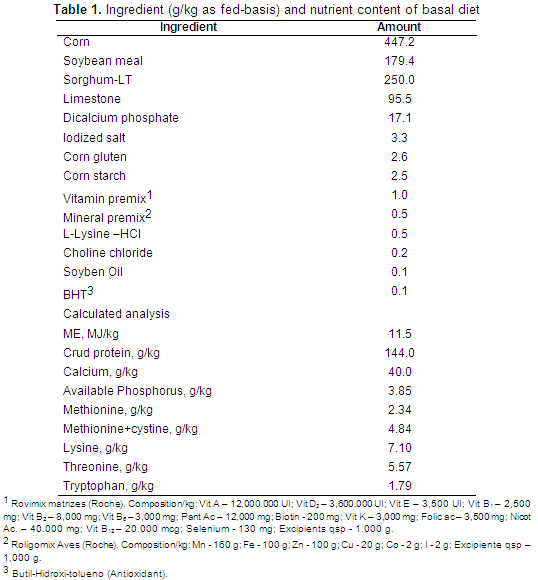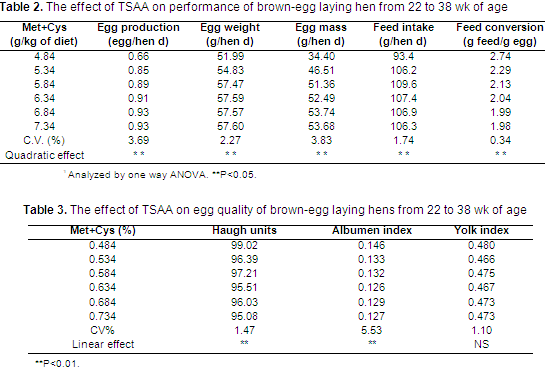|
Sulfur containing aminoacidsnutritional requirements for semi-heavy laying hens
ARTÍCULO DE
(Recibido: junio 25, 2013 Aprobado: septiembre 02, 2013 Actualizado: diciembre 20, 2013)
ABSTRACT: Todetermine the nutritional requirements of TSAA for semi-heavy laying hens estimated by regression models and LRP (linear response plateau).288 semi-heavy laying hens distributed in six treatments were fed from week 22 to week 38 with a basic diet containing 14.4% crude protein to which levels of DL-methionine was added (0.00; 0.05;0.10; 0.15; 0.20; and 0.25) in order to obtain treatments with 0.484, 0.534, 0.584, 0.634, 0.684, and 0.734% TSAA contents. Theincrease in the level of TSAA in the diet from 0.484 to 0.734% showeda quadratic effect on egg production, egg weight, egg mass, and feed conversion. A linear effect on the internal quality of the egg was also observed when measuring theHaugh units and the albumen index. Using single-slope, broken line methodology, the minimal levels of TSAA which maximized egg production, weight, and mass, and showed the best feed conversion were 6.72, 6.68, 6.72, and 6.82 g/kg of food respectively. In summary, the increase of TSAA using synthetic methionine significantly improved performance of eggs laying hens. Because of this reason semi-heavy egg laying hens required 6,735 g TSAA/kg of foodor 775 mg TSAA per hen daily from 22 to 38 weeksof age (with daily feed consumption of 115 g).
Key words: Cystine, methionine, TSSA, poultry
Requerimientos nutricionales de aminoácidos azufrados para aves de postura semipesadas
RESUMEN: Determinar los requerimientos nutricionales de Met+Cys para aves de postura semipesadas, estimados por medio de los modelos de regresión y el LRP (linear response plateau). 288 Aves de postura semipesadas distribuidas en seis tratamientos fueron alimentadas de la semana 22 a la semana 38 de edad, con una dieta básica que contenía 14,4% de proteína bruta a la cual se le adicionó seis niveles de DL-metionina (0,00; 0,05; 0,10; 0,15; 0,20 y 0,25%), para obtener tratamientos con 0,484; 0,534; 0,584; 0,634; 0,684 y 0,734% de Met+Cys. El nivel creciente de Met+Cys en la dieta, de 0,484 a 0,734% presentó un efecto cuadrático sobre la producción, peso de huevo, masa de huevo y conversión alimenticia. También se observó efecto lineal sobre el mejoramiento de la calidad interna del huevo al medir Unidades Haugh y el índice de albumen. Por medio del modelo LRP, los niveles mínimos de Met+Cys que maximizaron la producción, peso y masa de huevos y presentaron la mejor conversión alimenticia fueron los de 5,53, 5,85, 5,60 y 5,62 g de Met+Cys/kg de alimento, respectivamente. Ya a través del modelo cuadrático, los niveles de Met+Cys que maximizaron la producción, peso y masa de huevo y minimizaron la conversión alimenticia fueron 6,72, 6,68, 6,72 y 6,82 g/kg de alimento, respectivamente. En resumen, el incremento de Met+Cys utilizando DL-metionina mejoró significativamente el desempeño de las aves de postura. Por lo anterior, aves de postura semipesadas requieren 6.735 g de Met+Cys/kg de alimento o 775 mg de Met+Cys/ave/día de la semana 22 a la semana 38 de edad (con un consumo diario de 115 g/ave).
Palabras clave: Metionina, cistina, exigencias, ponedoras
Introducción
Based on the ideal protein concept, a protein supplies amino acids in exactly the amounts and proportions required by animals and can be 100% utilized under appropriate circumstances (Emmert & Barker, 1997; Barker, 2003). If one or two of essential amino acids are deficient, the excess amino acids will be wasted as N excretion, which is an environmental pollution source. Methione+cystine (TSAA) perform a number of functions in enzyme reactions and protein synthesis. Methionine is the first limiting amino acid in corn soybean meal diets in laying hens (Schutte & Van Werdem, 1978). Cystine can supply no more than 52% of the TSAA in chicks (Barker et al., 1996). There are several commercial crystalline amino acids such as DL-methionine and L-lysine available in the market. To efficiently use excess amino acids, the crystalline amino acids such as DL-methionine and L-lysine can be added to the diets to balance the amino acids. Novak et al. (2004), Liu et al. (2005) and Wu et al. (2005a) reported that increasing lysine or TSAA had positive effect on performance of laying hens.
It is important to know the TSAA and methionine requirements of laying hens. There are contradicting results in methionine and TSAA requirements of laying hens. NRC (1994) reported that brown-egg laying hens required 330 and 645 mg of methionine and TSAA per hen daily, respectively. Ahmad et al. (1997) reported that TSAA ranging from 580 to 660 mg per hen daily had no effect on performance of laying hens. However, Schutte et al. (1994) reported that the requirement for TSAA was about 740 mg per hen daily, of which about 440 mg was methionine. Cao et al. (1992) also reported that the requirement of methionine and TSAA were 424 and 785 mg per hen daily, respectively. In addition, there are differences in TSAA requirements estimated from different production parameters. Novak et al. (2004) reported that dietary TSAA level for maximum egg production was 811 mg per hen daily while TSAA for feed efficiency was 699 mg per hen daily.
Technological advances in genetics, managements, animal health and behavior have allowed laying hens to have better feed efficiency, bigger egg size, and longer persistence of the peak production. Thus, it is necessary to conduct research in nutritional requirements to optimize the utilization of nutrients so that laying hens can have the maximum genetic potential expression. Therefore, this experiment was designed to determine the nutritional requirements of TSAA for commercial brown-egg laying hens.
Materials and Methods
This experiment was conducted in Department of Zootechnia of the Agrarian Science Center of the Federal University of Viçosa, MG, Brazil. 288 Lohmann® brown hens were used. During the initial and growth phases the birds were managed following the recommendations of Lohmann Brown Management Guide (2005). After 17 weeks of age, the birds were transferred from the growth house to a production house (60 x 9 m2) with covered ceramic roofing tiles. Two hens were housed in conventional type cage (25 x 40 x 45 cm3).
From the 18 weeks of age, the birds had received increased stimulation of light until 17 hours of light daily at 27 week of age. Then 17 hours of light daily was maintained until the end of the experimental period. The temperature of air in the interior of the house was recorded at 7:00 AM for whole trial period. The average maximum (day time) and minimum temperatures (night) were 28.0 and 16.1ºC, respectively.
Before experiment, birds were randomly distributed to 6 treatments (6 replicates/treatment and 8 hens/replicate) based on body weight and egg production. From 22 week of age, hens were submitted to the treatments. Hens can drink water freely. This experiment lasted 16 weeks.
The treatments consisted of 6 diets. The addition of six levels of DL-methionine (0, 0.05, 0.10, 0.15, 0.20, 0.25%) to a basal diet containing 14.4% protein resulted in 0.484, 0.534, 0.584, 0.634, 0.684 and 0.734% TSAA contents. DL-methionine was produced by Degussa Corp., and contained at least 99% methionine activity. The basal diet (Table 1) was formulated to satisfy nutritional requirements, except methionine and TSAA, according to recommendations of NRC (1994). The proximal analysis for dietary energy, calcium, phosphorus, and protein contents of the basal diet was conducted at lab of animal nutrition Federal University of Viçosa, MG, Brazil. The amino acid compositions in ingredients including corn, soybean, and sorghum were analyzed by Degussa corp. (Sao Paulo, Brazil) to confirm TSAA and methionine contents in basal diets.
Eggs were collected every day. Egg production, egg weight (g), egg mass (g/hen d), feed consumption (g/hen d), feed conversion (g of feed/g of egg) were determined each 4 weeks. Eggs from each replicate were sampled for Haugh units, albumen index, and yolk index each 4 weeks. Yolk index = yolk diameter/yolk height. Albumen index = Albumen height/average of short and long diameter of albumen.
Data for each response criterion were analyzed in ANOVA using the GLM procedure of SAS (1996). Once differences among treatments were detected by one-way ANOVA, linear and quadratic effects were tested by contrast statements. Estimates of TSAA requirements for performance were estimated by subjecting treatment means to least squares broken line methodology (Robbins et al., 1979). The treatment means data for performance also were fitted to quadratic regression model to estimate TSAA requirements by using maximum or minimum asymptote.
Results
Methionine is the first limiting amino acid, followed by lysine in corn-soybean diets. Lysine is one of the most important factors in formulating diets. The basal diet contained 7.10 g/kg lysine. Based on average feed intake of 105 g/hen daily, 746 mg lysine was consumed per hen daily. Because lysine requirement for laying hens is around 720 mg per hen daily (Wu, 2005b), lysine contents in the diets of this experiment have fulfilled the requirement of lysine and can not affect the performance of laying hens.
There was a quadratic effect egg production with increasing TSAA in the diet (Table 2). Methionine supplementation in the basal diet increased egg production until the level of 6.84 g/kg of diet of TSAA. Increasing TSAA level from 0.684% to 0.734% had no improvement of egg production. These results are in agreement with those of Bertram et al. (1995), Liu et al. (2005) and Wu et al. (2005a). Who reported that increasing levels of TSAA improved egg production. Low egg production of hens fed the low TSAA levels in the present study can partially be attributed to amino acid imbalance, which causes the decrease of protein synthesis, inhibits absorption, and increases catabolism of the essential amino acid (Harper, 1956).
Increasing TSAA level had a quadratic effect on egg weight and egg mass (Table 2). Increasing TSAA level from 4.84 to 6.84 g/kg of diet increased egg weight and egg mass. However, further increase of TSAA from 6.84 to 7.34 g/kg of diet had no improvement on egg weight and egg mass. These results are consistent with those of Bertram et al. (1995), Liu et al. (2005) and Wu et al. (2005a). Who reported that increasing levels of TSAA increased egg weigh or egg mass.
Increasing TSAA level had a quadratic effect on feed intake (Table 2). Hens fed the diet containing 4.84 g TSAA/kg of diet had lower feed intake than hens fed other diets. Increasing TSAA from 4.84 to 6.84 g/kg of diet increased feed intake. Therefore, Methionine and TSAA level might be able to regulate feed consumption. Harper et al. (1970) reported TSAA could modify the plasmatic amino acid profile to activate appetite of animals.
There was a quadratic response of feed conversion to TSAA level (g feed/egg g) with increasing TSAA level (Table 2). Feed conversion was improved as TSAA level increased from 4.84 to 6.84 g/kg of diet. Increasing TSAA level from 6.84 to 7.34 g/kg of diet had no effect on feed conversion. These observations were in accordance with the results of Bertram et al. (1995), Novak et al. (2004), Liu et al. (2005) and Wu et al. (2005a). The explanation for the improved feed efficiency with increasing TSAA level might be attributed to more balanced amino acids.
When TSAA increased from 0.484 to 0.734, Haugh Unit linearly decreased from 97.07 to 94.57 (Table 3). Haugh Unit is a measure of the internal quality of an egg. This is done by determining the height of the albumen in relation to the egg’s weight. The reduction of Haugh unit with increasing TSAA level might be due to increased egg weight. Similarly results were found by Wu et al. (2005a). Increasing TSAA level had a linear effect on albumen index, but had no effect on yolk index. Decreased albumen index with increasing TSAA level might be attributed to increased egg size.
Discussion
Using single-slope, broken line methodology (Robbins et al., 1979), minimal break points for egg production, egg weight, egg mass, and feed conversion were 5.53, 5.85, 5.60, and 5.62 g TSAA/kg of diet (Table 4). Based on quadratic model, TSAA level that maximize egg production, egg weight, and egg mass, and minimize feed conversion were calculated to be 6.72, 6.68, 6.72, and 6.82 g/kg of diet. There are several methods used to estimate nutrient requirements. One is least squares broken line methodology (Robbins et al., 1979), which use break points as nutrient requirements. 90% of the upper asymptotic value of a quadratic fitted line was determined to be nutrient requirements Barker et al. (2002); Parr et al. (2003), estimate nutrient requirements by using the first intercept X-value of the broken line (on the plateau) and the quadratic fitted line. Nutrient requirements estimated from least squares broken line were less than those from quadratic regression. Similarly, Morris (1989) reported least squares broken line model might underestimate nutrient requirement. Because the cost of adding synthetic methionine is usually less than profits gained from improved performance and synthetic methionine is not toxic to laying hens, maximum or minimum asymptotic value of a quadratic fitted line was chosen to estimate nutrient requirement of TSAA for brown-egg laying hens in this experiment. The average value of TSAA levels maximizing egg production, egg weight, and egg mass, and minimizing feed conversion, was 6.735 g/kg of diet.
Haga clic sobre la imagen para ampliarla
Because average feed intake from 30 to 38 wk of age was close to or equal to 115 g/hen d, feed consumption of 115 g/hen d was used to calculate TSAA requirements. Based on quadratic model, laying hens required 6.735 g TSAA/kg of diet or 775 mg TSAA per hen daily from 22 to 38 wk of age (with feed consumption of 115 g). These values are very close to those of Cao et al. (1992); Schutte et al. (1994), who reported that the requirement for TSAA was about 785 and 740 mg per hen daily, respectively. NRC (1994) reported that brown-egg layers required 645 mg TSAA per hen daily. TSAA values estimated in this experiment are higher than NRC values probably because of improved egg production performance of laying hens in this experiment.
In conclusion, increasing TSAA by addition of synthetic methionine significantly improved performance of laying hens. Commercial brown-egg laying hens required 6.735 g TSAA/kg of diet or 775 mg TSAA per hen daily from 22 to 38 wk of age (with feed consumption of 115 g).
References
· Ahmad, H.A.; Bryant, M.M.; Kucuktas, S. et al. Econometric feeding and management for first cycle phase two Dekalb Delta hens. Poultry Science, v.76, n.9, p.1256-1263, 1997. · Baker, D.H. Ideal amino acid patterns for broiler chicks. In: D’Mello, F.JP. (Ed). Amino Acids in Animal Nutrition. 2nd ed. Wallingford: CAB International, 2003. p.223-235. · Baker, D.H.; Batal, A.B.; Parr, T.M. et al. Ideal ratio (relative to lysine) of tryptophan, threonine, isoleucine and valine for chicks during the second and third week of life. Poultry Science, v.81, p.485-494, 2002. · Baker, D.H.; Fernandez, S.R.; Webel, D.M. et al. Sulfur amino acid requirements and cystine replacement value of broiler chicks during the period three to six weeks posthatching. Poultry Science, v.75, n.6, p.737-742, 1996. · Bertram, H.L.; Danner, K.J.; Jeroch, H. Effect of DL-methionine in a cereal-pea diet on the performance ob brown laying hens. Arch Geflügelk, v.59, 1995, p.103-107. · Cao, Z.; Jevne, C.J.; Coon, C.N. The methionine requirement of laying hens as affected by dietary protein levels. Poultry Science, v.71, 1992 (suppl.39). · Emmert, J.L.; Barker, D.H. Use of the ideal protein concept for precision formulation of amino acid levels in broiler diets. Journal of Applied Poultry Research, v.6, p.462-470, 1997. · Harper, A.E. Amino acid imbalances, toxicities and antagonisms. Nutr Rev, v.14, n.8, p.225-227, 1956. · Harper, A.E.; Benevenga, N.J.; Wohlhueter, R.M. Effects of ingestion of disproportionate amounts of amino acids. Physiological Reviews, v.50, n.3, p.428-558, 1970. · Liu, Z.; Wu, G.; Bryant, M.M. et al. Influence of added synthetic lysine in low-protein diets with the methionine plus cysteine to lysine ratio maintained at 0.75. Journal of Applied Poultry Research, v.14, n.1, p.174-182, 2005. · Lohmann Tierzucht GMBH. Lohmann Brown Management Guide. Germany: German Lohmann Tierzucht GmbH, 2005. · Morris, T.R. The interpretation of response data from animal feeding trial. In: Cole, DJA & Haresign, W. (Eds). Recent Developments in Poultry Nutrition 2. Boston: Butterworths, 1989. p.1-11. · Novak, C.; Yakout, H.; Scheideler, S. The combined effects of dietary lysine and total sulfur amino acid level on egg production parameters and egg components in Dekalb Delta laying hens. Poultry Science, v.83, n.6, p.977-984, 2004. · NRC, National Research Council. Nutrients Requirements of Poultry. Washington D.C.: National Academic Press, 1994. · Parr, T.M.; Kerr, B.J.; Baker, D.H. Isoleucine requirement of growing (25 to 45 kg) pigs. Journal of Animal Science, v.81, n.3, p.745-752, 2003. · Robbins, K.R.; Norton, H.W.; Barker, D.H. Estimation of nutrient requirements from growth data. The Journal of Nutrition, v.109, p.1710-1714, 1979. · SAS Institute Inc. SAS® user’s guide: Statistics, Version 5.0. Ed. Cary, NC, USA, SAS Institute Inc., 1996. 956p. · Schutte, J.B.; De Jong, J.; Bertram, H.L. Requirement of the laying hen for sulfur amino acids. Poultry Science, v.73, n.2, p.274-280, 1994. · Schutte, J.B.; Van Werdem, E.J. Requirement of the hen for sulphur containing amino acids. British Poultry Science, v.19, n.5, p.573-581, 1978. · Wu, G.; Bryant, M.M.; Roland, D.A.Sr. et al. Effect of synthetic lysine on performance of commercial Leghorns in Phase II and III (Second Cycle) while maintaining the Methionine+Cysteine/Lysine ratio at 0.75. Poultry Science, v.84, p.2-22, 2005a (suppl.43). · Wu, G.; Bryant, M.M.; Voitle, R.A.; Roland, D.A.Sr. Effect of dietary energy on performance and egg composition in Bovans White and Dekalb White in Phase I. Poultry Science, v.84, n.10, p.1610-1615, 2005b.
Da Silva, M.; Rostagno, H.; Narváez-Solarte, W. Total sulfur amino acids nutritional requirements for brown-egg laying hens. Veterinaria y Zootecnia, v.7, n.2, p.54-62, 2013. < http://200.21.104.25/vetzootec/index.php?option=com_content&view=article&id=119> |





















